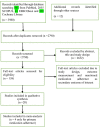Public health interventions on prescription redemptions and secondary medication adherence among type 2 diabetes patients: systematic review and meta-analysis of randomized controlled trials
- PMID: 34900834
- PMCID: PMC8630245
- DOI: 10.1007/s40200-021-00878-0
Public health interventions on prescription redemptions and secondary medication adherence among type 2 diabetes patients: systematic review and meta-analysis of randomized controlled trials
Abstract
Background: Despite the inadequate filling of prescriptions among chronic care patients has been a problem, little is known about the intervention effect on it.
Objective: The aim of this systematic review and meta-analysis (SRMA) was to investigate the effectiveness of various public health interventions on primary and secondary medication adherence among T2DM patients.
Methods: Searching was done from the major databases; Cochrane Library, Medline/PubMed, EBSCOhost, and SCOPUS. A hand search was made to find grey works of literature. Articles focused on interventions to enhance primary and secondary medication among type 2 diabetes mellitus patients were included. After screening and checking eligibility, the methodological quality was assessed. Secondary medication adherence was synthesized descriptively due to measurement and definition variations across studies. Finally, a meta-analysis was made using the fixed effects model for primary medication adherence.
Results: 3992 studies were screened for both primary and secondary medication adherences. Among these, 24 studies were included in the analysis for primary (5) and secondary (19) medication adherence. Pooled relative medication redemption difference was RD = 8% (95% CI: 6-11%) among the intervention groups. Age, intervention, provider setting, and IDF region were determinant factors of primary medication adherence. About two-thirds of the studies revealed that interventions were effective in improving secondary medication adherence.
Conclusion: Both primary and secondary medications were enhanced by a variety of public health interventions for patients worldwide. However, there is a scarcity of studies on primary medication adherence globally, and in resource-limited settings for the type of adherences.
Supplementary information: The online version contains supplementary material available at 10.1007/s40200-021-00878-0.
Keywords: Intervention; Medication adherence; RCT; T2DM; meta-analysis.
© Springer Nature Switzerland AG 2021.
Conflict of interest statement
Conflict of interestAuthors have no conflict of interest.
Figures




References
Publication types
LinkOut - more resources
Full Text Sources
Miscellaneous

